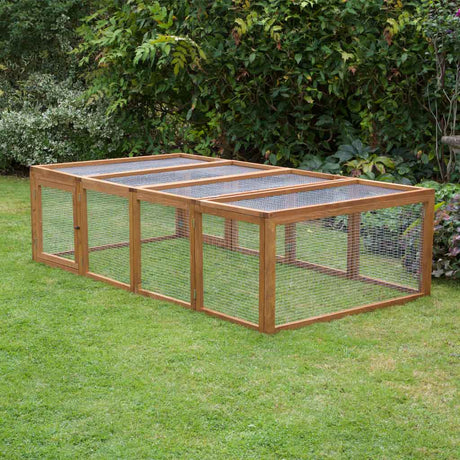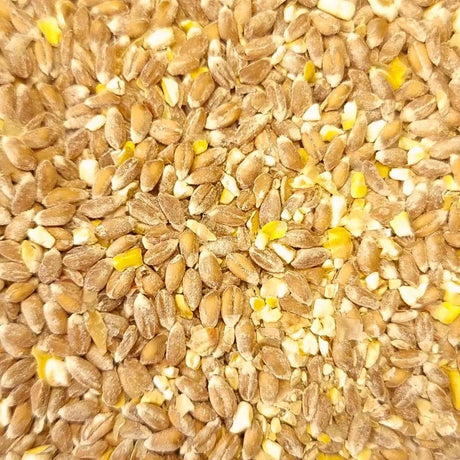If you love wildlife and encourage hedgehogs, birds and more into your garden, it won't be long before you get to wondering what's going on out there at night. The answer? Well, a trail cam could be one solution, but if you want to be up close and personal with the action as it happens then a pair of night vision binoculars are what you need.
Night vision binoculars are no longer the preserve of James Bond and David Attenborough. You don't have to be a spy or professional naturalist to own and enjoy a pair. Once costly, bulky and not that practical for most of us, night vision binoculars have dramatically dropped in price and risen in quality over the past few years.
If you enjoy watching wildlife and have a hankering to see a little more of what's going on at night, now could be the time to invest in a pair.
In this guide, we will look at the things you need to consider when buying a pair of night vision binoculars, and our picks for the best models available in the UK right now.
Our Top Picks
| Nightfox 100V | £ | Best Entry Level | Read Review | Check Prices |
| Bushnell Equinox Z2 | £££ | Best Monocular | Read Review | Check Prices |
| Solomark 7x | £££ | Best Magnification | Read Review | Check Prices |
| Nightfox Swift | ££ | Best Goggles | Read Review | Check Prices |
| Nightfox 110R | ££ | Best All Rounder | Read Review | Check Prices |
The Best Night Vision Binoculars - a Buyers Guide.
How Do Night Vision Binoculars Work?
To get an understanding of what you can expect from night vision binoculars, it's good to have some idea of how they work.
We can't see at night because there isn't enough light around in the section of the spectrum that human eyes can register.

Night vision binoculars enhance the image before us by amplifying the available light in two ways.
Optoelectronic Image Enhancement.
This is the traditional method. It works by capturing the small amounts of infra-red light available at night and enhancing it electronically. Then it uses an image-enhancing vacuum tube to amplify the light before projecting it onto a screen to produce the glowing green night vision image we are used to seeing.
When you are shopping for Optoelectronic night vision binoculars, you will see references to "Generation 1, 2" etc. The higher the generation number, the better the image quality and the higher the price.
For most people using night vision binoculars for wildlife watching, generation 1 or 2 offer a good balance between function and cost.
Digital Image Enhancement
Most night vision devices today use Digital Image Enhancement. Digital devices amplify the available light using a CMOS sensor, which is also used in digital cameras. This means they don't need the vacuum tube and can be smaller and lighter than Optoelectronic devices. It also allows them to produce colour images rather than the glowing green variety.
Early digital night vision binoculars were expensive and didn't offer the image clarity of traditional models. But digital technology is getting better and cheaper all the time.
Because Digital devices are using camera technology, it's also possible to have them take and record pictures or video. As well as viewing on an internal LCD screen, some will allow you to connect to external devices for viewing.
What to Consider When Buying Your Night Vision Binoculars
This is a complicated technology, and there are many things to consider when choosing which model to buy. You will see a whole mass of technical specifications in product descriptions. Great if you know what they mean, but
Think about how you will be using the binoculars, which will help you decide which features will be most important to you.
Technical Specifications
Image Quality and Resolution
Image quality is one of the most important factors to consider. But it's also one of the most difficult to assess from the technical specifications as several binocular features contribute to image quality. The factors impacting on image quality will vary depending on the technology your binoculars are built with. The generation of the vacuum tubes, the power of the light amplification unit, the wattage of Infrared Illuminators and the CMOS sensor's size can all have an impact.
Resolution is a term often used in relation to image quality. The higher the resolution, the sharper your image is going to be.
When looking at digital models you need to consider both the resolution of the binoculars viewing screen and the sensor's resolution as both will impact the clarity of what you see.
There is a trade-off between resolution and price. There comes a point where you can be paying for higher and higher resolution without actually being able to see any difference at all.
Infrared Illuminators
An infrared illuminator works like a flash on your camera. It adds extra light to the scene.
For night vision devices, infrared illuminators add infrared light. This is invisible to the human eye but will help your binoculars to capture a better picture.
The binoculars you choose should have built-in infrared illuminators, and the option for a variety of levels will allow them to adapt to different situations.
Magnification
Though magnification is what you buy day time binoculars for, don't get too excited about the magnification in night vision binoculars.

Whilst standard binoculars can offer magnification of 10x or more don't expect this from night vision models. It's just not possible in low light conditions.
For most night vision binoculars you can expect 1x to 5x optical magnification.
This may be enhanced with variable le digital magnification or zoom. Digital magnification has its place, But those of you who understand a bit about how cameras work will know that whilst optical magnification actually adds detail to the picture, digital magnification just "crops" the image, to bring you closer to what was already there. So the image can get blurry or "pixilated".
So, optical magnification is the thing you really need to look out for.
You will often see magnification expressed as 5x35 or 3x40, for example. The first number refers to the actual magnification. The second number is the diameter of the objective lens. This is the lens that collects light into the binoculars. If you see binoculars with WA after these numbers, so "5x35 WA" for example, this means the lens is wide-angle, and you can expect a wide field of view.
Realistically though, if you are using your binoculars to look at wildlife at night you are probably going to be focusing on things that are relatively near to you, maybe 100-150 meters away at most (think 30 meters ranks as a long garden in most UK homes), so lack of high magnification isn't really going to be that much of an issue.
Field of View
Field of view is the area you can see through your binoculars. It's important because a wider field of view makes it easier to spot activity and track wildlife without continually moving your head and binoculars.
The field of view is usually expressed as degrees, or feet at 100 meters. Either way, the higher the number, the wider area you will be able to see.
There is a relationship between optical magnification and field of view. The greater the optical magnification, the narrower the field of view. This is a real consideration in daylight binoculars, where high magnification is possible, not so much of a concern in night vision models where only relatively low powered magnification is achievable.
Range
Range is the distance at which the binoculars will be able to detect and focus on objects.
Like most things, there is a trade-off between range and price - the more you are prepared to pay the higher range you can get.
But before you take out a second mortgage, think what sort of range you really need?
Remember, for night wildlife viewing you are not really going to be trying to spot things at a great distance. Instead, you'll be using your binoculars to take a closer, sharper look at things that are relatively close by.
So for most people a maximum range of 100 - 150 yards is plenty.
It's also worth looking out for minimum range, or “close focus” though this is often not specified. This is the closest you can be to an object and still focus on it.
If you plan to use your binoculars to view wildlife in your garden at night near range could be important. A close range of 10 feet is typical for night vision binoculars with some of our picks having a close focus of as little as 30cm.
Other Factors To Consider
In addition to the core technical specifications, there are many other features of night vision binoculars you will want to take into account when choosing a pair.
Size and Weight
Night vision binoculars can be huge and heavy. You may not mind this, but if you plan to spend some time holding the binoculars up to your eyes, or if you want to travel with them, or take them hiking or canoeing a smaller, lighter pair could be an advantage.
The heaviest set we review here comes in at just under a kilo, with the lightest a little over 300gms, so you can see there is plenty of variation.
Build Quality and Water/Weatherproofing
Even if it's only in your garden, you will likely be using your binoculars outdoors in the dark. It may well be wet, and the darkness makes bumping or dropping your kit all the more likely.
So build quality is important. Look at product specifications and reviews in this area. Fully rubberised models are good idea, at a minimum look for solidly built models with nice rubberised grips.
You can get fully waterproofed models and a price and this may be useful for you if you plan on taking your binoculars boating. For all users weatherproofing will be useful and this a a feature to look out for.
Battery Life
You can expect at least three hours battery life from most models, and in many situations this will be enough.
But if you plan to travel or camp with your binoculars, you might want to look at more extended life versions.
It's also worth looking at whether your chosen pair works with rechargeable batteries from a cost point of view.
Viewing
Though optoelectronic binoculars come with traditional eye pieces most digital models come with an LCD viewing screen.

The screen will show images in black and white or traditional green (often in colour for day viewing.
The size and resolution of the screen will impact on the quality of your view. Think of the size of your mobile phone screen for comparison. And just like a mobile phone, bigger screens tend to mean a bigger, heavier device, so there’s a trade off.
Many NV binoculars now offer video and still recording with the option to play back on a computer, mobile or TV. In this case the size of the built in screen becomes less of an issue.
Day and Night Use.
As we've noted, night vision binoculars do not have the magnification capabilities of daylight models, but still, it could be convenient to be able to use your NV binoculars in the day too especially if you want to travel or camp with your binoculars and don't want to pack two pairs.
If you want to use your NV binoculars during the day, be sure to check that this feature is available. Exposure to bright light can damage intensifier tubes (but not CMOS sensors) so check before exposing your equipment to light.
Manual Focus
In addition to all the digital focus and zoom capabilities on most of these binoculars, you should also have the ability to focus them manually.
The easiest way to do this is with a central focus wheel. Look out for this feature.
Eye Relief
Eye relief is the distance your eye can be from the viewing lens and still see the whole picture.
This can be an issue for some people who wear glasses. If you are wearing glasses for regular long or short-sightedness, you should remove them when using binoculars and use the manual focus to adjust.
But if you wear glasses for nystagmus or astigmatism, you may need to keep them on. In this case, it's best to go for a long eye relief of at least 11mm.
Of course many of the models we are looking at here substitute an LCD screen for the traditional eye-piece, making the eye relief issue less of a problem.
Lens Coatings
Bright light sources like street lights, or a full moon can play havoc with night vision binoculars reflecting off the lenses and spoiling image quality.
Look for models with fully coated lenses to avoid this problem.
Anti-Fogging
This is another useful feature to look out for. Cold and damp night time conditions can cause lenses and screens to fog. Some models come with anti-fogging coatings.
It's a good feature to look out for.
Ease of Use
You're going to be using this bit of kit in the dark, probably outdoors, and likely to see the activity of sometimes fast-moving creatures.
So ease of use is essential. You don't want to be fumbling about for the right button just as the hedgehogs you've seen start mating.
Look for models with a limited number of controls. Decently sized buttons well spaced and easy to reach.
Recording Ability.
NV binoculars use digital camera technology, so it's relatively easy to add the ability to take still photographs and record video.
The reasons why this might be a nice feature to have are fairly obvious.
On the flip side, adding recording capability also adds weight, size, cost and complexity.
It's going to be a personal choice. Is capturing the action on film important to you? Or will you be happier to simply be in the moment and enjoy giving your full attention to watching what's going on?
Cost
You can easily spend thousands of pounds on a pair of night vision binoculars. But for wildlife watching your really don't need to.
All the binoculars reviewed in the guide come in under £500 with our entry level pick costing just £99 at the time of writing.
Binoculars, Monocular or Goggles?
Before you take the plunge into night vision kit, it might be worth thinking about which format will be best for you.
Binoculars suit most people and most situations. The downside, particularly for NV binoculars, is that they can be bulky and heavy.
A monocular is basically a mini-telescope, so half the size of a set of binoculars with viewing through just one eye. If compactness and lightness are important to you, they might be worth considering. Though you will get a narrower field of view.
Goggles are binoculars designed to be strapped to your head. Often more expensive than a standard NV binocular they are the solution for you if you want to use night vision whilst on the move yourself.
Beware "Low Light" Binoculars
As you search for night vision binoculars, you will come across lots of models that claim to have great "low light" capabilities. These can look attractive because the starting prices are often much lower than those of true night vision binoculars.
Don't be fooled, though. These models are cheaper because they don't use night vision technology. They may be fine at dawn or dusk or on a cloudy day, but if you actually want to see things at night, you are going to be disappointed. They won't work in the dark.
Best Night Vision Binoculars UK
Here we give you a full rundown of some of the best night vision binoculars available in the UK. We've given you a clear summary of the features and specifications of each. So you can decide which best meets your needs.
Best Entry Level Binoculars - Nightfox 100V Digital Night Vision Binoculars
Performance
- Magnification: 3x optical plus 2x digital,
- Field of View: 15 degrees,
- Range: 100 meters in full darkness
- Close Focus: 30cm
- Infrared Illuminators: Yes, 7 levels
Features
- Weight: 603gms
- Dimensions: 185x145x55mm
- Battery Life: 6 Hours
- Power Source: 8 x AA Batteries
- Day Use: Yes
- Recording Ability: No
- Ease Of Use: Excellent
- Build Quality: Sturdy
- Other: 18 Month Warranty
If you are looking for a pair of night vision binoculars for garden or holiday wildlife watching these are a great choice at a great price.
Nightfox is a British brand which has set out to deliver reliable technology at affordable prices. In their own words, binoculars "that won't break, and won't break the bank."
Judging by the number of rave reviews they have and their Amazon and Trustpilot ratings, they achieve just that.
The 100V is a solidly-made, simple to use, piece of kit which delivers well on all the basics you would be looking for from a night vision binocular, at an outstanding price.
The binoculars are pretty light and small for NV equipment, they seem solidly made and offer nice rubberised grips.
There are just three buttons, making operation super-simple.
They keep the price, size and weight of this model down by sticking to the basics. For some people, the downside of these binoculars will be that they don't offer the facility to records stills or videos.
Nightfox stand by their claim of reliability by offering an 18-month warranty as standard.
We think these will be an excellent choice for a first pair of night vision binoculars and very hard to beat.
Best Monocular - Bushnell Equinox Z2 6x50
Performance
- Magnification: 6x optical
- Field of View: 15 degrees,
- Range: 305 meters in full darkness
- Close Focus: N/A
- Infrared Illuminators: Yes,
Features
- Weight: 765gms
- Dimensions: 191x98x64mm
- Battery Life: N/A
- Power Source: 4 x AA Batteries
- Day Use: Yes
- Recording Ability: Yes
- Ease Of Use: Good
- Build Quality: Solid
- Other: Live stream video to a mobile and remote control via an app.
Bushnell is a high-end optics manufacturer with a sound reputation, and this monocular is an excellent example of their work.
Being a monocular, you get a compact and highly portable instrument. However, it isn't especially lightweight.
You are paying for the excellent 6x optical magnification, which is a high level for night vision kit.
Also, the Bushnell is WiFi-enabled, allowing you to record HD video and stills, and live stream to a mobile phone. You can also remotely control the monocular via an app.
This means that you have a device that crosses over, between night vision binocular and trail cam.
The basics on this monocular are high quality, and the additional functionality makes it an exciting option.
Best Magnification - Solomark Night Vision Binoculars 7x
Performance
- Magnification: 7x optical plus 2x digital zoom
- Field of View: N/A
- Range: 400meters in full darkness
- Close Focus: N/A
- Infrared Illuminators: Yes, 3 levels
Features
- Weight: 997gms
- Dimensions: N/A
- Battery Life: N/A
- Power Source: 8 x AA Batteries
- Day Use: Yes
- Recording Ability: Yes
- Ease Of Use: Fair
- Build Quality: Good
- Other: includes SD card for recording and AV cable.
The big deal with these NV binoculars is the 7x optical magnification, which is high for night vision and will get you up close and personal with pretty much anything you want to take a look at in the dark.
The 400 meter range is also impressive and combined with the magnification make these the most powerful binoculars on our list.
The large 4 inch LDC screen makes viewing very comfortable and the daytime image in full colour.
These binoculars come with fully coated lenses to prevent glare and are weatherproofed.
These are not the most lightweight binoculars we are looking at, coming in at a whisper under 1 kilo. Controls are perhaps a little more fiddly than those on some of the other models.
But 7x magnification, video and stills recording and daytime use mean they are a binocular that can really multi-task for you and offers excellent performance.-
Best Goggles - Nightfox Swift Night Vision Goggles.
Performance
- Magnification: 1 x optical plus 2 x digital zoom
- Field of View: 33 degrees
- Range: 70 meters in full darkness
- Close Focus: 30cm
- Infrared Illuminators: Yes, 3 levels
Features
- Weight: 360 gms
- Dimensions: 170x140x70mm
- Battery Life: 3 hours
- Power Source: Integrated rechargeable lithium battery.
- Day Use: Yes
- Recording Ability: Yes
- Ease Of Use: Excellent
- Build Quality: Excellent
- Other: Includes head mount, neck strap and 18-month warranty.
Back to Nightfox for our pick of the best goggles.
If you are opting for a night vision goggle, you want to be able to move with them on.
For this you need them to be lightweight, and not offer too much magnification. High levels of magnification when you are moving just become disorientating and are likely to end up with you nose down in the mud.
The Nightfox Swift gets it right on both counts. The unit is very lightweight coming in at just 360gms and 1x fixed optical magnification. There is also an excellent 33 degree field of view, which is also important when you are moving around.
The controls are super simple, which is even more critical if you are on the move in the dark.
USB rechargeable batteries have a 3-hour life and keep costs and unit weight down, and the robust build quality is what you would expect from Nightfox.
If you plan to be on the move after dark, these goggles have everything you need.
Best All-Rounder - Nightfox 110R
Performance
- Magnification: 7 x optical magnification plus 2 x digital zoom.
- Field of View: 15 degrees,
- Range: 150 meters in full darkness
- Close Focus: 30cm
- Infrared Illuminators: Yes
Features
- Weight: 374gms
- Dimensions: 160x130x55mm
- Battery Life: up to 5 Hours
- Power Source: 4 x rechargeable AA Batteries
- Day Use: Yes
- Recording Ability: Yes
- Ease Of Use: Good
- Build Quality: Sturdy
- Other: 18 Month Warranty
With enhanced magnification and IR illumination plus the ability to record stills and video combined with the simplicity and reliability Nightfox is renowned for these NV binoculars' top pick for the best all-rounder.
The price point is very attractive too.
7 x optical magnification on this model puts it at the top of the range for night vision binoculars. And the more powerful built-in IR illuminators push the range up to an impressive 150 meters.
This model offers the ability to record video and stills onto a micro SD card (not included) and playback on the device, or download using the micro USB connector included.
There is more functionality in the model, or you have a few more buttons to tackle. But controls are kept simple and well-positioned for ease of use.
The build quality is sturdy, and the unit is light and compact. Add this to top-notch customer service, and you can see why this product gets top marks from us.
Choosing The Best Night Vision Binoculars for You
A pair of night vision binoculars can certainly offer a new way of getting close to wildlife. And once you have started watching the activities of nocturnal creatures, whether, in your garden or further afield, you could easily get addicted.
There is a wealth of choice in the NV marketplace. It can be confusing, and if you are looking for your first pair of night vision binoculars, it can be challenging to know where to start.
In this post, we've tried to explain some of the terminologies you are likely to see what these specifications will mean for you when you buy and use a pair of night vision binoculars.
We've highlighted some reputable manufacturers and picked some of the binoculars available now, which we feel are best in class.
But in the end, the best night vision binoculars will be the ones that work best for you. We hope we've given you some ideas on how to choose.
We hope you've found this post useful. If you have questions or suggestions we would love to hear them, leave us a comment below. And of course, we would love to see your night vision photos or video footage; you can share that in the comments too.















3 comments
Your blog post was a valuable read. I found the content to be informative, and I appreciated the way you addressed potential challenges and provided solutions. To gain further knowledge on this topic, click here.
Hi, this is great! I see those you have picutred are all recordable ones, what is your view and suggestion for non battery operated NV binoculars?
Many thanks
Sophie
Looking for a pair of night vision binoculars as a gift for friends. Came across your article which was very helpful, especially the information about technical specifications. This really helped identify what to look for when choosing the right binoculars for their garden.